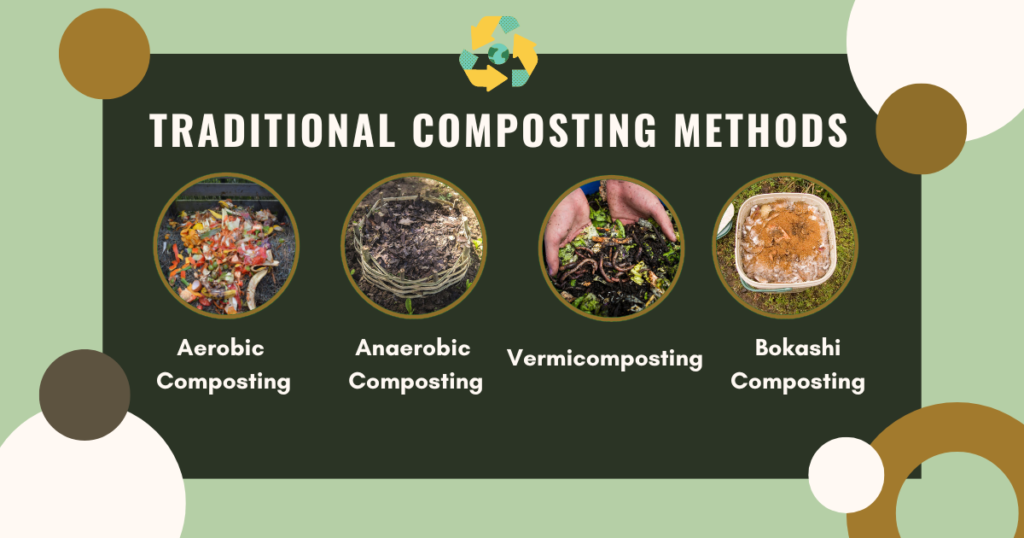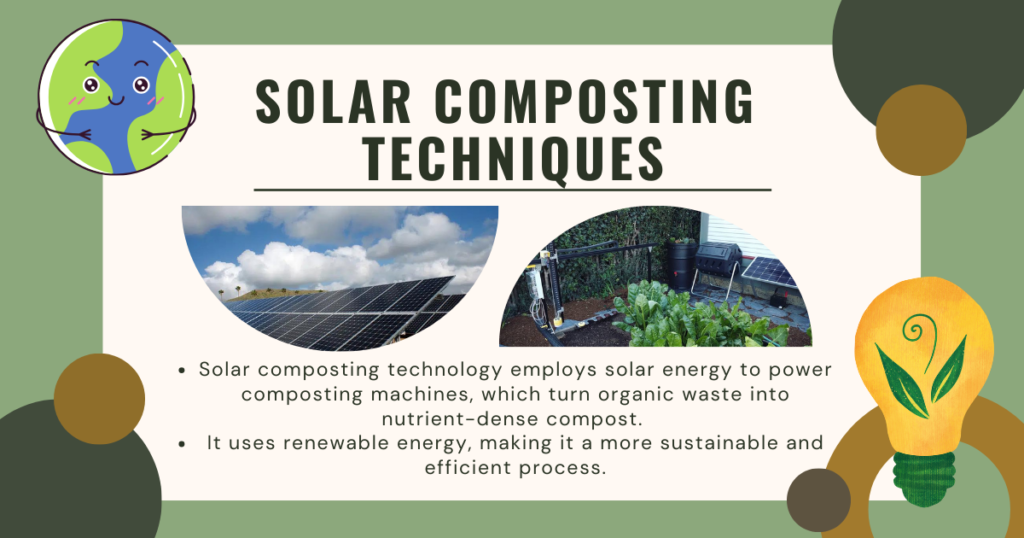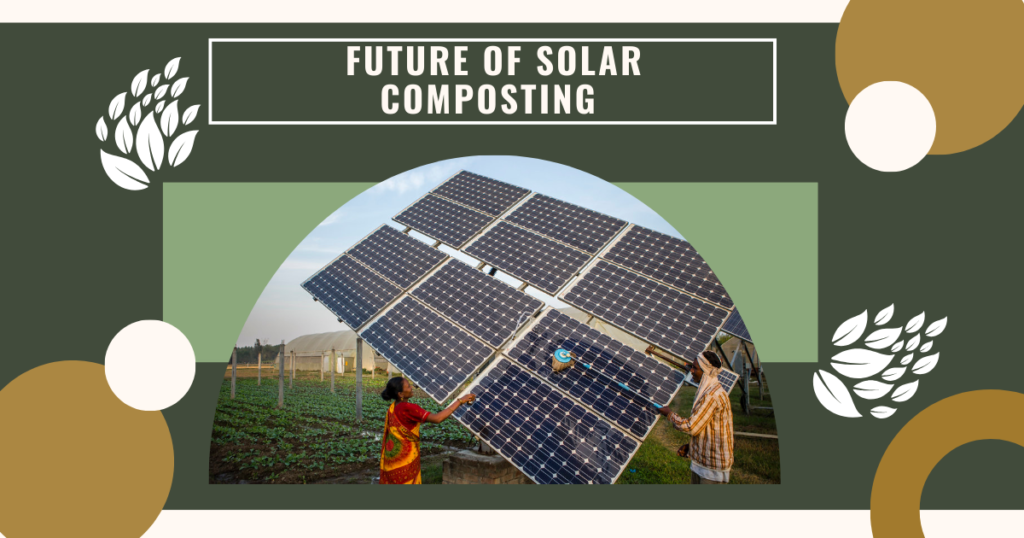Benefits of Solar Composting Techniques for Home and Commercial Uses in Comparison to Traditional Methods.
Composting is becoming a widely used technique for handling organic waste as society comes to value sustainability more and more. But not every composting technique is made equal. This article explores the advantages of solar-powered composting over conventional techniques, emphasizing why it’s a better option for residential and business settings.
Overview of Traditional Composting Methods
Traditional composting techniques mostly depend on insects, fungus, and microbes to aid in the natural breakdown processes. These techniques typically fit into one or two major categories:
- Aerobic Composting
- Anaerobic Composting
- Vermicomposting
- Bokashi Composting

Aerobic Composting
Process:
- Material Gathering and Layering: Compost or a container is used to gather and layer organic waste. Brown materials (rich in carbon) like leaves and straw are interspersed with green (nitrogen-rich) resources like kitchen trash and grass clippings.
- Aeration: The organic waste is broken down by aerobic bacteria, which depend on oxygen, which is introduced into the compost pile through regular turning.
- Control of Moisture: Microbiological activity depends on maintaining an appropriate level of moisture. It should be as wet as a sponge when the pile is piled high.
- Decomposition and Maturation: As the organic material ages, bacteria break it down and produce heat in the process. The pile gets smaller and turns into dark, rich compost.
Anaerobic Composting
Process:
- Sealed Environment: To create an oxygen-free environment, organic waste is disposed of in an airtight pit or container.
- Slow Decomposition: Anaerobic microorganisms break down the material over a long period of time, usually several months to a year, in the absence of oxygen.
- Leachate Management: In order to avoid contamination, the process leaves behind a liquid byproduct known as leachate that needs to be controlled.
Vermicomposting
Process:
- Worm Bin Setup: Organic waste is placed in a worm bin and red worms (Eisenia fetida) are added.
- Feeding and Maintenance: The worms eat the organic material, converting it into a very nutritious compost known as worm castings.
- Harvesting: New organic waste is fed to the bin and worm castings are periodically harvested.
Bokashi Composting
Process:
- Fermentation: Organic waste is deposited in a Bokashi bucket and coated with Bokashi bran enriched with beneficial bacteria.
- Sealed Environment: The bucket is sealed to provide an anaerobic environment for fermentation.
- Fermentation Period: After approximately two weeks, the trash can be buried in soil to complete decomposition.
What is Solar Composting?
Solar composting technology employs solar energy to power composting machines, which turn organic waste into nutrient-dense compost. Unlike traditional composting, which frequently relies on manual labor or fossil fuel-powered machinery, solar composting uses renewable energy, making it a more sustainable and efficient process.

Know More:- Solar-Powered Home & Commercial Use Composting Machine
How Solar Composting Works
Collection and Sorting:
Organic garbage is collected and sifted to remove all non-compostable materials. This guarantees that the composting process is efficient and that the finished compost is of good quality.
Solar-Powered Processing:
Solar panels mounted on or near the composting unit collect sunshine and convert it to electricity. This electricity runs the composting machine, which shreds and aerates the organic waste, speeding up the decomposition process.
Temperature and Moisture Control:
Advanced solar composting systems use sensors to optimize microbial activity by controlling temperature and moisture levels. Maintaining optimal conditions promotes speedy and effective decomposition, resulting in high-quality compost.
Compost Maturation:
Beneficial bacteria break down the processed organic waste as it matures. The maturing phase guarantees that the compost is nutrient-dense and suitable for use in gardens, farms, and landscaping projects.
Benefits of Solar Composting Techniques over Traditional Composting Methods:
Benefits of Composting |
Sr.no. |
Solar Composting Techniques |
Traditional Composting Methods |
| Environmental Impact | 1. | Diminished Carbon Footprint | High Emissions |
| 2. | Conservation Of Natural Resources | Resources Intensive | |
| Cost Efficiency | 1. | Reduced Long-term Costs | Increased Operational Expenditure |
| 2. | Energy Independence | Dependency on Energy Markets | |
| Operational Efficiency | 1. | Consistent Compost Production | Intermittent Operation |
| 2. | Low Maintenance | Increased Maintenaces Needs | |
| Health & Safety | 1. | Decreased Emissions | Increased Emissions |
| 2. | Lower Fire Risk | Increased Fire Risk | |
| Quality of Compost | 1. | Advanced Features | Variable Quality |
| 2. | Faster Processing | Slower Processing |
1. Environmental Impact:
Solar Composting:
- Diminished Carbon Footprint: Composting machines driven by solar energy rely on renewable energy sources, resulting in a notable reduction of greenhouse gas emissions.
- Conservation of Natural Resources: These systems reduce dependency on non-renewable resources by using solar energy, which helps to create a more sustainable ecosystem.
Traditional Methods:
- High Emissions: Because conventional composting techniques frequently rely on fossil fuels or electricity, they have a higher carbon emission rate.
- Resource-intensive: These techniques demand large energy inputs, which accelerates environmental degradation and depletes non-renewable resources.
2. Cost Efficiency:
Solar Composting:
- Reduced Long-Term Costs: By doing away with energy expenditures, solar composting systems save money over time, even though they need a larger initial investment.
- Energy Independence: The steady operating expenses of solar composting systems result from their immunity to shifting energy prices.
Traditional Methods:
- Increased Operational expenditures: Over time, traditional composting becomes more expensive due to ongoing energy expenditures associated with fuel or electricity.
- Dependency on Energy Markets: The profitability of these strategies is impacted by increases in energy prices as well as interruptions in supply.
3. Operational Efficiency:
Solar Composting:
- Consistent Compost Production: Solar composting machines with battery storage have the ability to run continuously, guaranteeing a steady output of compost.
- Low Maintenance: In general, solar systems require less maintenance, which lowers related expenses and downtime.
Traditional Methods:
- Intermittent Operation: The composting process may experience pauses if it is dependent on outside energy sources.
- Increased Maintenance Needs: Conventional systems frequently need more regular maintenance, which raises the cost of operating and reduces downtime.
4. Health & Safety:
Solar Composting:
- Decreased Emissions: Solar composting reduces air pollution by employing renewable energy, which improves the environment.
- Lower Fire Risk: Compared to conventional combustion engines, these technologies pose fewer fire risks.
Traditional Methods:
- Increased Emissions: Composting driven by fossil fuels can exacerbate health problems and bad air quality.
- Increased Fire Risk: Combustion engine-based traditional technologies are more likely to overheat and catch fire.
5. Quality of Compost:
Solar Composting:
- Advanced Features: Solar-powered equipment frequently has temperature and moisture control, which makes compost of a higher caliber more quickly.
- Faster Processing: By quickening the composting process, these systems can produce nutrient-rich compost more quickly.
Traditional Methods:
- Variable Quality: In the absence of sophisticated controls, compost’s quality can change and occasionally call for further processing.
- Slower Processing: Compost may take longer to produce using conventional procedures, which would postpone its usability.

Read More:- Future of Composting: Solar Innovations for Sustainable & Organic Waste Management System
Conclusion: Why Solar Composting is the Future?
The advantages of solar composting technology over conventional techniques are evident. Because solar composting reduces emissions and conserves resources, it has major environmental benefits. In terms of economics, it offers energy independence and long-term savings, and in terms of operations, it guarantees consistent, effective production with less maintenance requirements. Because of its advanced processing features, compost has a superior quality and improves health and safety by reducing emissions and fire hazards.
In conclusion, solar composting is the best option for both residential and business applications since it is a progressive, environmentally friendly method of handling organic waste. In light of our ongoing search for environmentally friendly solutions, solar composting stands out as a game-changing innovation that supports our sustainability objectives.
